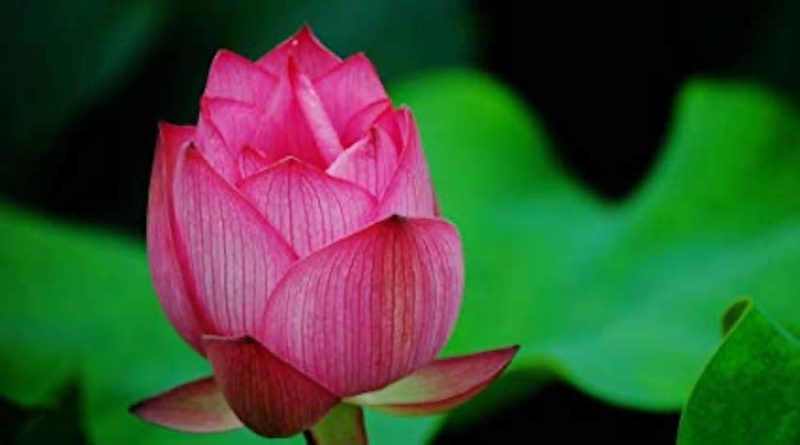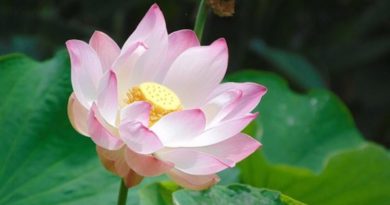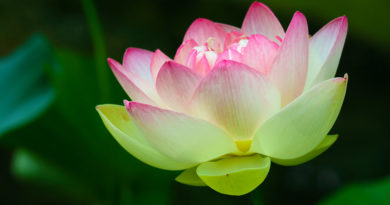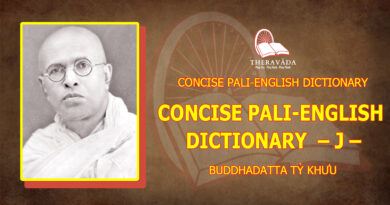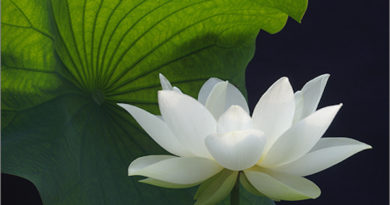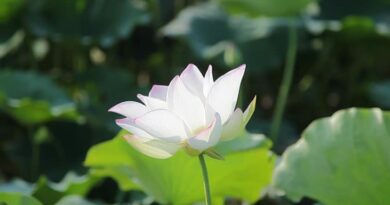THEORY OF KARMA – CLASSIFICATION OF KARMA
THEORY OF KARMA – CLASSIFICATION OF KARMA
(A) With respect to different functions, Karma is classified into four kinds:
1. REPRODUCTIVE KARMA
Every birth is conditioned by a past good or bad karma, which predominated at the moment of death. Karma that conditions the future birth is called Reproductive Karma. The death of a person is merely ‘a temporary end of a temporary phenomenon’. Though the present form perishes, another form which is neither the same nor absolutely different takes its place, according to the potential thought-vibration generated at the death moment, because the Karmic force which propels the life-flux still survives. It is this last thought, which is technically called Reproductive (janaka) Karma, that determines the state of a person in his subsequent birth. This may be either a good or bad Karma.
According to the Commentary, Reproductive Karma is that which produces mental aggregates and material aggregates at the moment of conception. The initial consciousness, which is termed the patisandhi rebirth consciousness, is conditioned by this Reproductive (janaka) Karma. Simultaneous with the arising of the rebirth-consciousness, there arise the ‘body-decad’, ‘sex-decad’ and ‘base-decad’ (kaya-bhavavatthu dasakas). (decad = 10 factors).
(a) The body-decad is composed of:
- The element of extension (pathavi).
- The element of cohesion (apo).
- The element of heat (tajo).
- The element of motion (vayo).
(b) The four derivatives (upadana rupa):
- Colour (vanna).
- Odour (gandha).
- Taste (rasa).
- Nutritive Essence (oja)
These eight (mahabhuta 4 + upadana 4 = 8) are collectively called Avinibhoga Rupa (indivisable form or indivisable matter).
(c) Vitality (jivitindriya) and Body (kaya)
These (avinibhoga 8 + jivitindriya 1 + Kaya 1 = 10) ten are collectively called “Body-decad” = (Kaya dasaka).
Sex-decad and Base-decad also consist of the first nine, sex (bhava) and seat of consciousness (vathu) respectively (i.e. eye, ear, nose, tongue, and body).
From this, it is evident that the sex of a person is determined at the very conception of a being. It is conditioned by Karma and is not a fortuitous combination of sperm and ovum cells. The Pain and Happiness one experiences in the course of one’s lifetime are the inevitable consequence of Reproductive Kamma.
2. SUPPORTIVE KARMA
That which comes near the Reproductive (janaka) Kamma and supports it. It is neither good nor bad and it assists or maintains the action of the Reproductive (janaka) Karma in the course of one’s lifetime. Immediately after conception till the death moment this Karma steps forward to support the Reproductive Karma. A moral supportive (kusala upathambhaka) Karma assists in giving health, wealth, happiness etc. to the being born with a moral Reproductive Karma. An immoral supportive Karma, on the other hand, assists in giving pain, sorrow, etc. to the being born with an immoral reproductive (akusala janaka) Karma, as for instance to a beast of burden.
3. OBSTRUCTIVE KARMA OR COUNTERACTIVE KARMA
Which, unlike the former, tends to weaken, interrupt and retard the fruition of the Reproductive Karma. For instance, a person born with a good Reproductive Karma may be subject to various ailments etc., thus preventing him from enjoying the blissful results of his good actions. An animal, on the other hand, who is born with a bad Reproductive Karma may lead a comfortable life by getting good food, lodging, etc., as a result of his good counteractive or obstructive (upabidaka) Karma preventing the fruition of the evil Reproductive Karma.
4. DESTRUCTIVE (UPAGHATAKA) KARMA
According to the law of Karma the potential energy of the Reproductive Karma could be nullified by a mere powerful opposing Karma of the past, which, seeking an opportunity, may quite unexpectedly operate, just as a powerful counteractive force can obstruct the path of a flying arrow and bring it down to the ground. Such an action is called Destructive (upaghataka) Karma, which is more effective than the previous two in that it is not only obstructive but also destroys the whole force. This Destructive Karma also may be either good or bad.
As an instance of operation of all the four, the case of Devadatta, who attempted to kill the Buddha and who caused a schism in the Sangha (disciples of the Buddha) may be cited. His good Reproductive Karma brought him birth in a royal family. His continued comfort and prosperity were due to the action of the Supportive Karma. The Counteractive or Obstructive Karma came into operation when he was subject to much humiliation as a result of his being excommunicated from the Sangha. Finally the Destructive Karma brought his life to a miserable end.
(B) There is another classification of Karma, according to the priority of effect:
WEIGHTY (GARUKA) KARMA.
This is either weighty or serious – may be either good or bad. It produces its results in this life or in the next for certain. If good, it is purely mental as in the case of Jhana (ecstasy or absorption). Otherwise it is verbal or bodily. On the Immoral side, there are five immediate effective heinous crimes (pancanantariya karma): Matricide, Patricide, and the murder of an Arahant, the wounding of a Buddha and the creation of a schism in the Sangha. Permanent Scepticism (Niyata Micchaditthi) is also termed one of the Weighty (garuka) Karmas.
If, for instance, any person were to develop the jhana (ecstasy or absorption) and later were to commit one of these heinous crimes, his good Karma would be obliterated by the powerful evil Karma. His subsequent birth would be conditioned by the evil Karma in spite of his having gained the jhana earlier. Devadatta lost his psychic power and was born in an evil state, because he wounded the Buddha and caused a schism in the Sangha.
King Ajatasattu would have attained the first stage of Sainthood (Sotapanna) if he had not committed patricide. In this case the powerful evil Karma acted as an obstacle to his gaining Sainthood.
PROXIMATE (ASANNA) KARMA OR DEATH-PROXIMATE KARMA
This is that which one does or remembers immediately before the moment of dying. Owing to the great part it plays in determining the future birth, much importance is attained to this deathbed (asanna) Karma in almost all Buddhist countries. The customs of reminding the dying man of good deeds and making him do good acts on his deathbed still prevails in Buddhist countries.
Sometimes a bad person may die happily and receive a good birth if he remembers or does a good act at the last moment. A story runs that a certain executioner who casually happened to give some alms to the Venerable Sariputta remembered this good act at the dying moment and was born in a state of bliss. This does not mean that although he enjoys a good birth he will be exempt from the effects of the evil deeds which he accumulated during his lifetime. They will have there due effect as occasions arise.
At times a good person may die unhappy by suddenly remembering an evil act of his or by harbouring some unpleasant thought, perchance compelled by unfavourable circumstances. In the scriptures, Queen Mallika, the consort of King Kosala, remembering a lie she had uttered, suffered for about seven days in a state of misery when she lied to her husband to cover some misbehaviour.
These are exceptional cases. Such reverse changes of birth account for the birth of virtuous children to vicious parents and of vicious children to virtuous parents. As a result of the last thought moment being conditioned by the general conduct of the person.
HABITUAL (ACCINA) KARMA
It is that which on habitually performs and recollects and for which one has a great liking. Habits whether good or bad becomes ones second nature, tending to form the character of a person. At unguarded moments one often lapses into one’s habitual mental mindset. In the same way, at the death-moment, unless influenced by other circumstances, one usually recalls to mind one’s habitual deeds.
Cunda, a butcher, who was living in the vicinity of the Buddha’s monastery, died yelling like an animal because he was earning his living by slaughtering pigs.
King Dutthagamini of Ceylon (Sri Lanka) was in the habit of giving alms to the Bhikkhus (monks) before he took his own meals. It was his habitual Karma that gladdened him at the dying moment and gave him birth in the Tusita heaven.
RESERVE OR CUMULATIVE (KATATTA) KARMA
This literally means ‘because done’. All actions that are not included in the aforementioned and those actions soon forgotten belong to this category. This is, as it were the reserve fund of a particular being.
(C) There is another classification of Karma according to the time in which effects are worked out:
Immediately Effective (ditthadhammavedaniya) Karma.
Subsequently Effective (uppapajjavedaniya) Karma.
Indefinitely Effective (aparapariyavedaniya) Karma.
Defunct or Ineffective (ahosi) Karma.
(D) The last classification of Karma is according to the plane in which the effect takes place, namely:
Evil Actions (akusala kamma) which may ripen in the sentient planes (kammaloka). (Six celestial planes plus one human plane plus four woeful planes = eleven kamaloka planes.) Here are only four woeful kamalokas.
Good Actions (kusala kamma) which may ripen in the sentient planes except for the four woeful planes.
Good Actions (kusala kamma) which may ripen in the Realm of Form (rupa brahamalokas). There are four Arupa Brahma Lokas.

